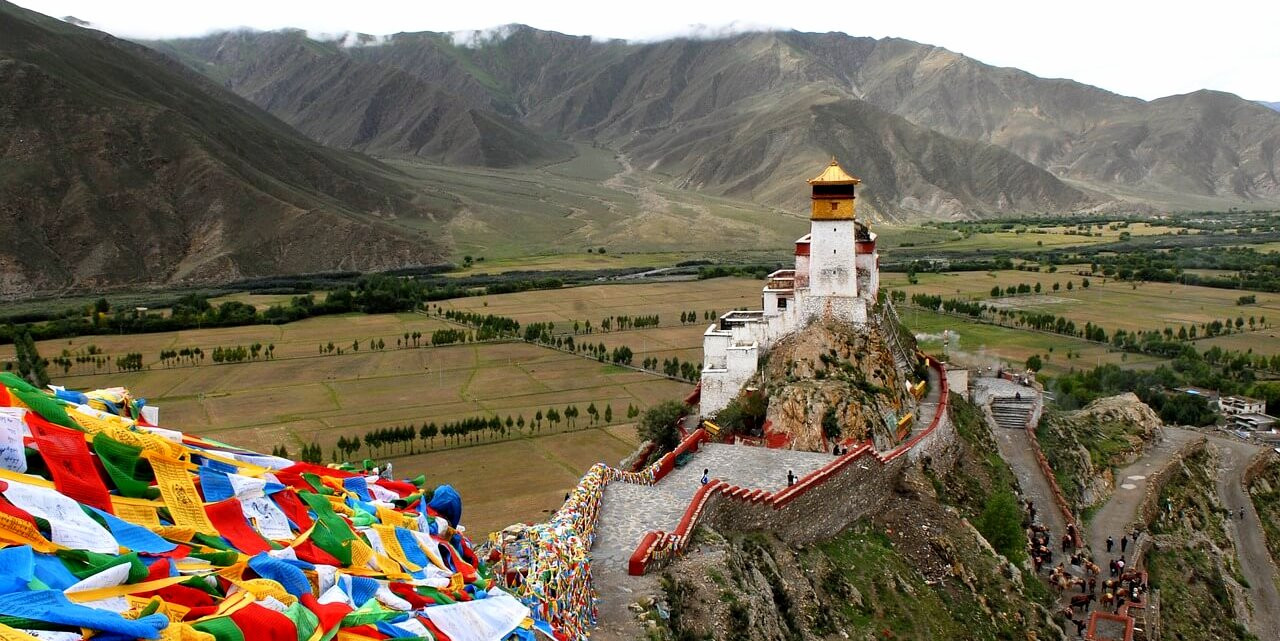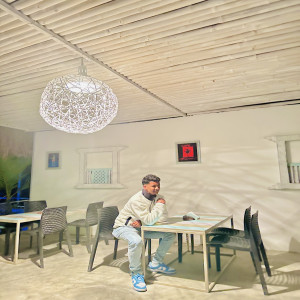Potala Palace
The Potala Palace in Lhasa is not only one of the most famous places in Tibet but also a masterpiece of architecture and a sacred spiritual centre. As one of the key Tibetan landmarks, it represents the soul of Tibetan Buddhism and continues to draw pilgrims, historians, and tourists from across the globe.
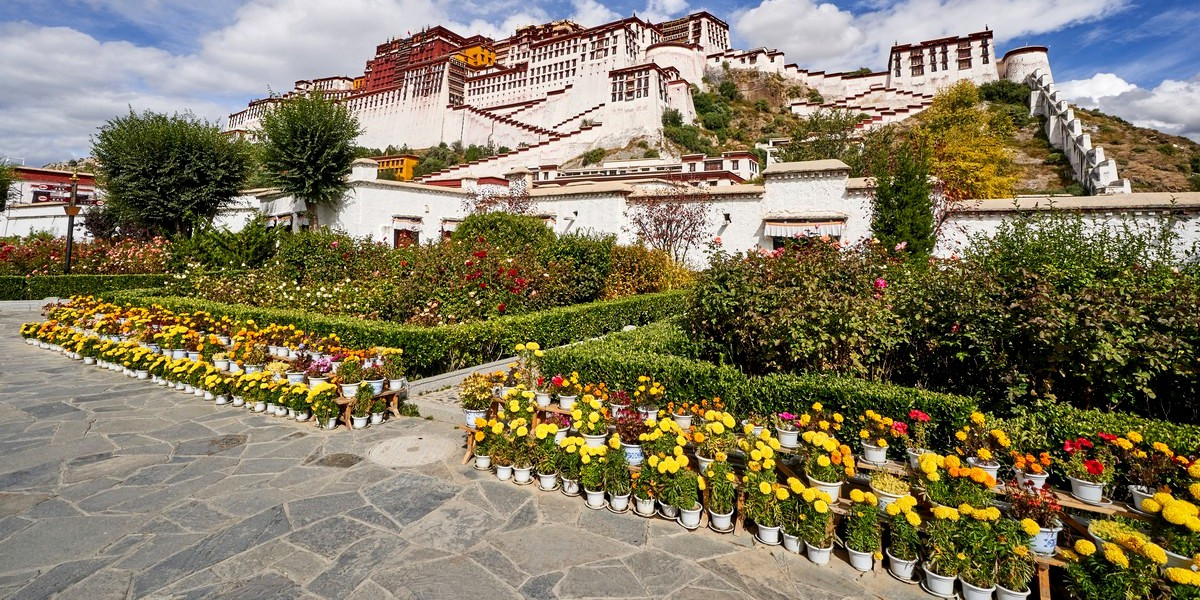
-
Historical Background: The palace was first constructed by King Songtsen Gampo and later reconstructed and expanded in the 17th century by the 5th Dalai Lama. He transformed it into the official winter residence for successive Dalai Lamas, cementing its role in Tibetan governance and spirituality.
-
Location and View: Its elevated position gives it a commanding view of Lhasa, making it one of the most iconic and photogenic Tibet travel destinations. From any point in the city, the palace’s striking silhouette dominates the skyline.
-
Cultural and Religious Significance: Once the seat of Tibetan government and now a pilgrimage site, the palace houses ancient murals, scriptures, relics, and tombs of past Dalai Lamas. It’s an essential stop among spiritual sites in Tibet to explore, and a must for those interested in Tibetan monasteries to visit.
-
UNESCO Recognition: Its unmatched beauty and cultural importance earned the Potala Palace a place on the list of UNESCO sites in Tibet. It stands as one of the top tourist attractions in Tibet and a key highlight in any Tibet travel guide: top destinations.
-
Tourist Experience: Tourists can explore chapels, religious galleries, and the golden tombs of the Dalai Lamas, adorned with jewels and intricate carvings. The palace is often recommended in lists of things to do in Tibet for first-time visitors and must-see places in Tibet.
-
Preservation Efforts: Due to its age and fragile structure, significant efforts have been made by the Chinese government and international bodies to preserve the palace. These initiatives ensure that future generations can continue to admire this cultural treasure.
The Potala Palace is more than just an architectural wonder—it's a living symbol of Tibetan identity, spirituality, and resilience. For travellers seeking the best places to visit in Tibet, this monumental structure stands as a profound and unforgettable experience.
Mount Everest Base Camp
Located in the shadow of the world’s tallest peak, the Mount Everest Base Camp (Tibet side) offers an unmatched combination of adventure, serenity, and spiritual awe. It’s not only one of the best places to visit in Tibet, but also a once-in-a-lifetime experience for trekkers, photographers, and mountain lovers.
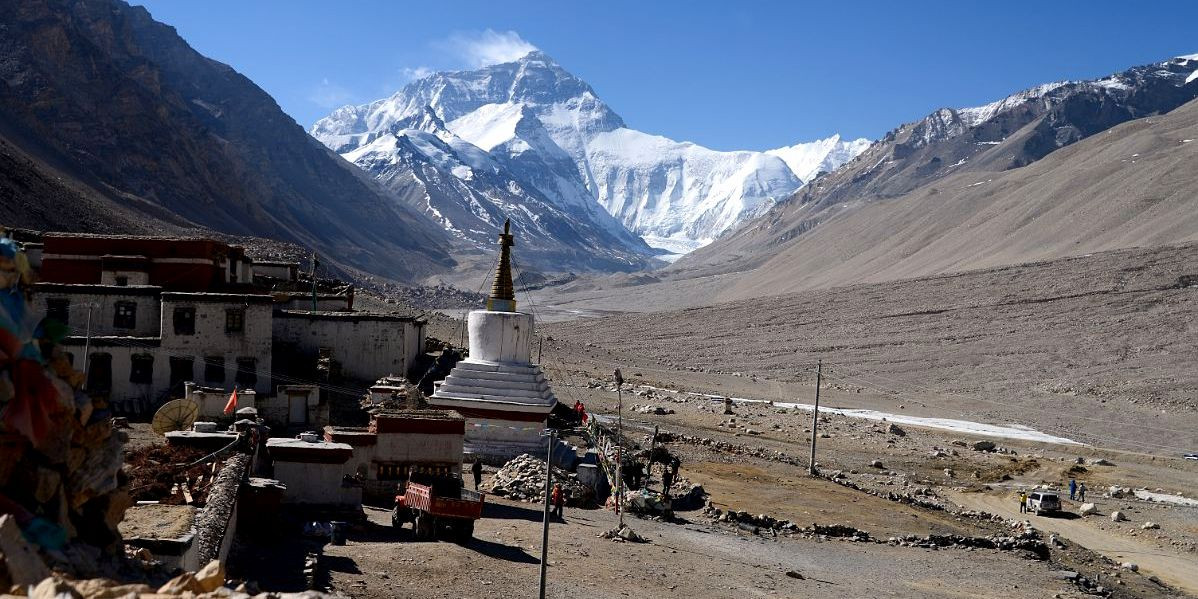
-
Location: Situated at an elevation of approximately 5,200 meters, the north base camp provides direct access to the stunning north face of Mount Everest. It’s accessible by vehicle, making it one of the most reachable high-altitude Tibet travel destinations.
-
Scenic Appeal: The Tibet side of Mount Everest Base Camp offers some of the clearest and most dramatic views of Everest’s summit. It is a top choice among beautiful places in Tibet for photography, particularly at sunrise and sunset when the peak glows in golden hues.
-
Spiritual and Cultural Significance: Near the base camp lies Rongbuk Monastery, the highest monastery in the world. It adds a spiritual dimension to the adventure, making it one of the most unique spiritual sites in Tibet to explore.
-
Accessibility: Unlike the Nepal side, which requires multi-day trekking, the Tibet side is accessible via a paved road from Lhasa through Shigatse. This makes it ideal for those looking for a high-altitude experience without long treks—perfect for things to do in Tibet for first-time visitors.
-
Tourist Experience: Visitors can camp near the base (weather permitting), enjoy panoramic mountain views, and interact with local Tibetan communities. The site is often included in curated tours focusing on Tibet tourism highlights and Tibet sightseeing spots.
-
UNESCO and Global Importance: The Everest region is globally significant for both its ecological and cultural richness, earning its place among the most important UNESCO sites in Tibet and top tourist attractions in Tibet.
Visiting the Mount Everest Base Camp (Tibet side) is more than just reaching a destination—it's about standing face-to-face with nature’s grandeur and experiencing the essence of the Himalayas. As one of the most awe-inspiring Tibet travel destinations, it offers the perfect mix of natural beauty, cultural depth, and accessibility for travellers seeking something truly unforgettable.
Jokhang Temple
Located in the old town of Lhasa, Jokhang Temple is the most sacred and spiritually significant temple in all of Tibet. Revered by pilgrims and visitors alike, it stands as one of the most important spiritual sites in Tibet to explore and an essential destination for anyone seeking a deeper understanding of Tibetan culture and faith.
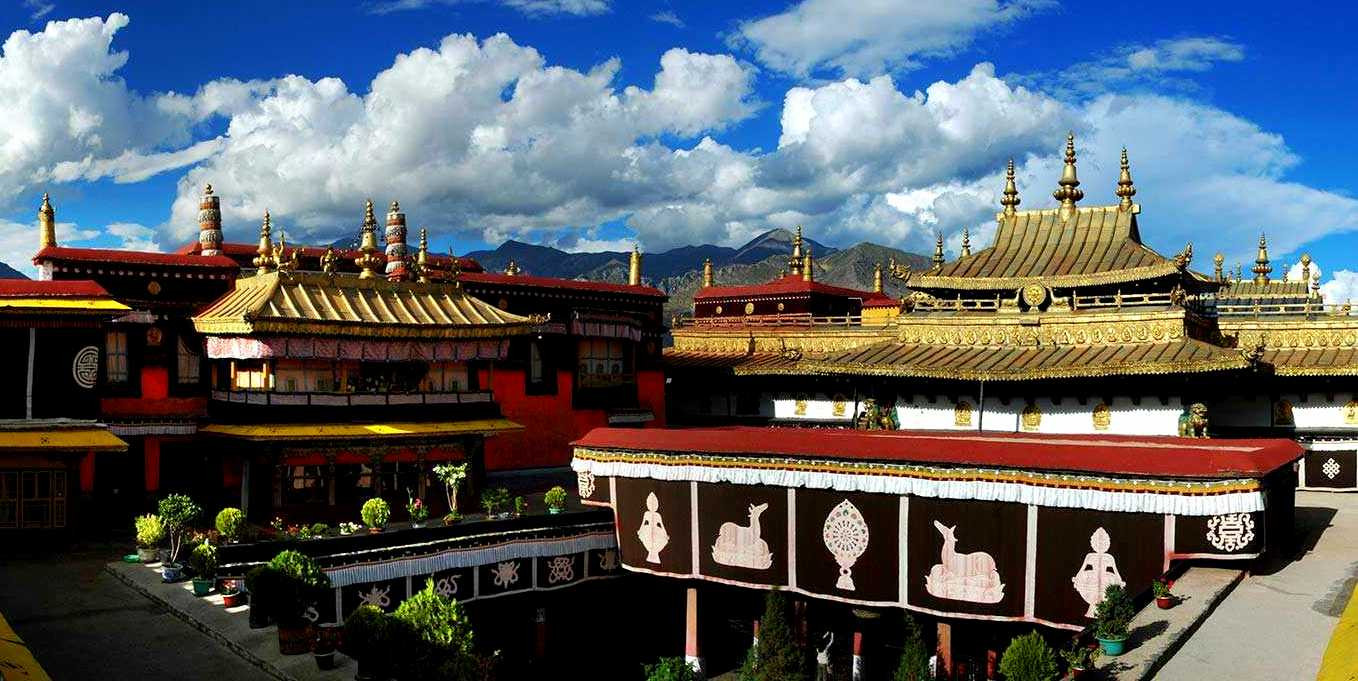
-
Location: Situated in the bustling Barkhor area, the temple lies at the spiritual centre of Lhasa and is surrounded by a vibrant circuit walked daily by countless pilgrims.
-
Religious Importance: Jokhang Temple is considered the holiest destination for Tibetan Buddhists. It houses the Jowo Rinpoche, a revered life-sized statue of Buddha Shakyamuni brought to Tibet by Princess Wencheng in the 7th century.
-
Historical Background: The temple was constructed to honour the arrival of Buddhism in Tibet and has been continuously expanded and restored over the centuries. It is deeply tied to the country’s spiritual and historical development, making it one of the top Tibetan landmarks.
-
Architectural Significance: Jokhang Temple showcases a unique architectural fusion, symbolic of Tibet’s early Buddhist roots. The golden roof, intricate murals, and multi-tiered design make it a masterpiece among Tibet sightseeing spots.
-
Cultural Experience: Pilgrims from across Tibet journey for days or even weeks to walk the kora (sacred path) around the temple, spinning prayer wheels and prostrating in devotion. The atmosphere is alive with chants, incense, and deep spiritual energy.
-
UNESCO Recognition: The temple is listed as a World Heritage Site by UNESCO and is closely tied to other key Tibet travel destinations, such as the Potala and Norbulingka Palaces.
-
Accessibility: As one of the top Lhasa must-visit locations, Jokhang Temple is centrally located and walkable from major hotels and attractions.
Jokhang Temple is more than a historic structure—it’s the living, beating heart of Tibetan Buddhism. For anyone looking into the top 10 places to visit in Tibet, this temple provides not only historical insight but a deeply moving cultural and spiritual experience. A journey to Lhasa is incomplete without standing before its sacred doors.
Namtso Lake
Regarded as one of the most stunning scenic lakes in Tibet, Namtso Lake (meaning “Heavenly Lake” in Tibetan) is a breathtaking high-altitude saltwater lake located in northern Tibet. With its turquoise waters, vast open skies, and surrounding snow-capped mountains, it’s one of the best places to visit in Tibet for nature lovers and spiritual seekers alike.

-
Location: Located at an elevation of approximately 4,718 meters, Namtso Lake is one of the highest saltwater lakes in the world. The drive from Lhasa takes around 4–5 hours, passing through the scenic Nyenchen Tanglha mountain range.
-
Natural Beauty: The lake is known for its crystal-clear blue waters that reflect the surrounding peaks. The serene, untouched environment makes it a favourite among beautiful places in Tibet for photography and meditation.
-
Religious Significance: Namtso is one of the three holy lakes in Tibet and a popular pilgrimage destination. It’s especially visited during the Year of the Sheep in the Tibetan calendar, when spiritual merit is believed to be greatly enhanced.
-
Cultural Connection: Surrounding the lake are ancient meditation caves and hermitages used by monks and pilgrims for centuries. The sense of peace and isolation offers a rare glimpse into the spiritual solitude of Tibetan practice.
-
Wildlife and Landscape: The lake and its surrounding grasslands support a variety of wildlife, including yaks, sheep, and migratory birds. During summer, Tibetan nomads set up tents, giving visitors a glimpse into traditional lifestyles.
-
Accessibility: Thanks to improvements in infrastructure, Namtso can now be accessed by vehicle from Lhasa in a day trip or overnight excursion, making it a convenient stop in many Tibet travel guides: top destinations.
Namtso Lake is a perfect combination of natural grandeur and spiritual calm. Its raw beauty, religious relevance, and peaceful environment make it a must-see among the top tourist attractions in Tibet. For travellers seeking a deeper connection with nature and Tibetan culture, this is one of the most unforgettable Tibet travel destinations.
Samye Monastery
As the cradle of Tibetan Buddhism, Samye Monastery holds a unique place in Tibetan history and spirituality. Revered for being the very first Buddhist monastery in Tibet, it is one of the most profound spiritual sites in Tibet to explore and a cornerstone in the story of Tibet’s religious evolution.
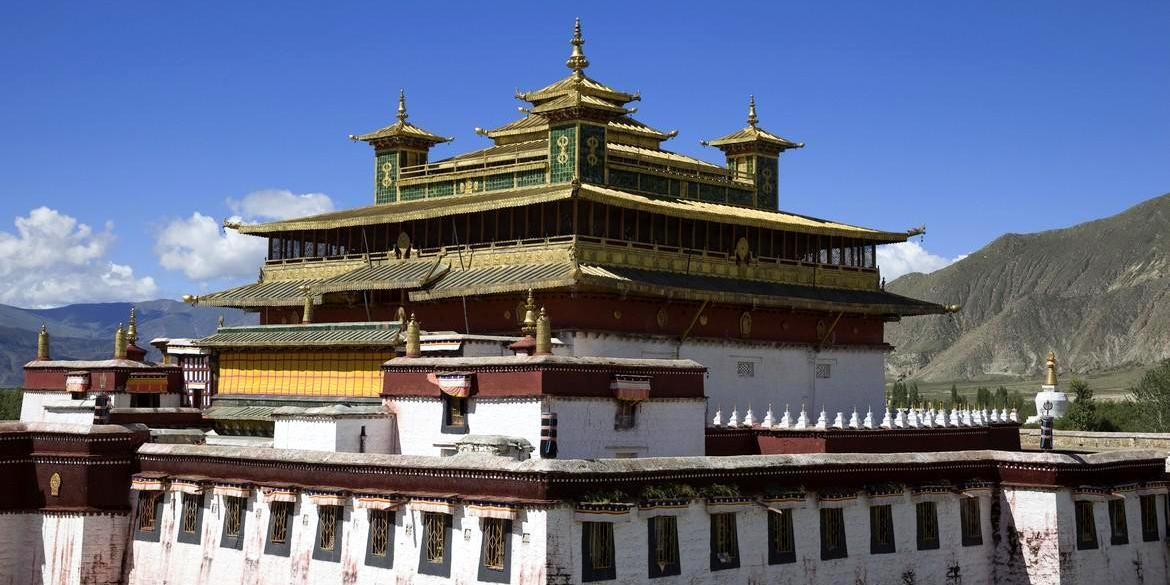
-
Location: Located about 170 km southeast of Lhasa, Samye Monastery lies near the Yarlung Tsangpo River and is accessible via a scenic drive followed by a short ferry or road trip.
-
Historical Significance: Founded during the reign of King Trisong Detsen with the guidance of Indian master Padmasambhava and scholar Shantarakshita, Samye was the first monastery in Tibet to house fully ordained monks, marking the formal introduction of Buddhism into Tibetan society.
-
Architectural Importance: The monastery's design reflects a giant mandala, symbolising the Buddhist universe. It blends Indian, Chinese, and Tibetan architectural styles, making it one of the most unique and culturally rich Tibetan landmarks.
-
Religious Relevance: Samye continues to be a major pilgrimage destination, especially for Tibetan Buddhists following the Nyingma tradition. It is surrounded by smaller chapels, stupas, and sacred sites, each with its spiritual significance.
-
Cultural Treasures: The monastery houses ancient wall paintings, Sanskrit scriptures, and bronze statues that trace Tibet's religious development. It’s an important destination for anyone interested in Tibetan monasteries to visit, and a famous place in Tibet with rich historical layers.
-
Visitor Experience: Unlike more tourist-heavy sites, Samye offers an authentic, serene environment for reflection and cultural immersion. Visitors can explore the central Utse temple, walk the symbolic kora around the grounds, and observe the daily life of local monks.
-
Accessibility: Getting to Samye involves a scenic drive from Lhasa, often combined with visits to other historical sites in the Yarlung Valley. It’s a great addition to longer cultural itineraries focused on Tibet tourism highlights.
Samye Monastery is more than just a religious site—it is the foundation of Buddhism in Tibet. For those seeking depth, authenticity, and historical context, Samye is a must on any journey through the top 10 places to visit in Tibet. Its spiritual gravity and unique architecture make it an essential experience for every curious traveller.
Yamdrok Lake
Among the most breathtaking scenic lakes in Tibet, Yamdrok Lake is famous for its dazzling turquoisecolourr, spiritual importance, and spectacular mountain surroundings. It is one of the best places to visit in Tibet for its stunning beauty and cultural depth, making it favouritete stop on the journey from Lhasa to Gyantse and Shigatse.
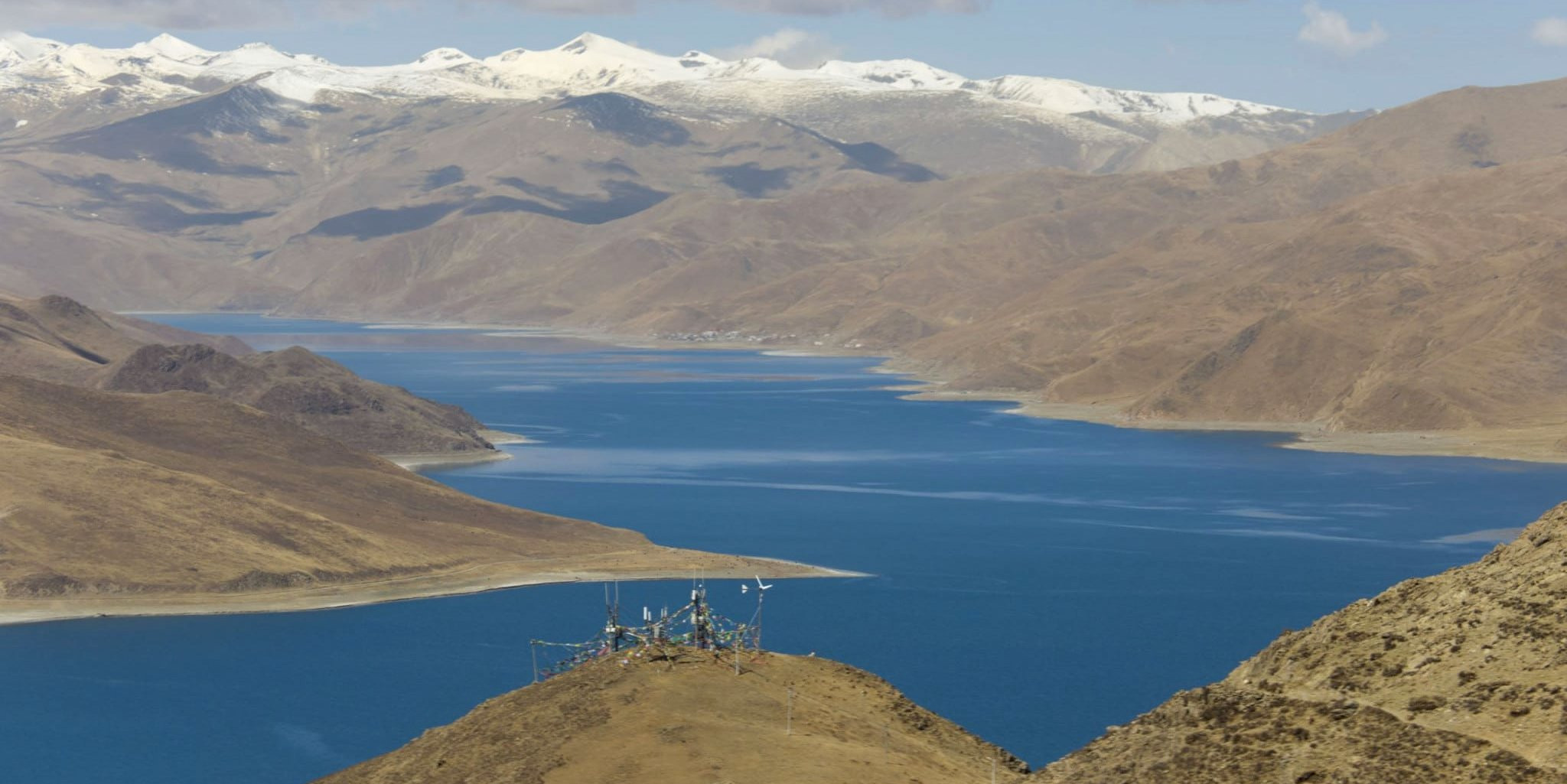
-
Location: Yamdrok Lake lies at an altitude of over 4,400 meters, easily reachable by road. It's often visited as part of day trips from Lhasa or en route to other major Tibet travel destinations.
-
Natural Beauty: With its deep turquoise waters and the backdrop of snow-capped mountains like Mt. Nojin Kangtsang, Yamdrok is a top pick among beautiful places in Tibet for photography. The lake stretches over 70 km and is dotted with small islands and vibrant landscapes.
-
Religious Significance: Yamdrok is considered sacred by Tibetan Buddhists and is believed to be the transformation of a goddess. Pilgrims often visit to make offerings and pray for blessings, making it one of the most spiritually meaningful sites in Tibet to explore.
-
Cultural Relevance: The lake is associated with Tibetan prophecies and believed to influence the well-being of the entire region. It’s an important spiritual and geographical landmark for local communities.
-
Accessibility: The drive to Yamdrok Lake includes winding mountain roads and passes such as Kamba La (4,794 meters), which offers panoramic views of the lake from above—an essential photo stop and one of the most memorable Tibet sightseeing spots.
Yamdrok Lake is a perfect blend of spiritual reverence and natural splendour. Its vibrant colours, high-altitude charm, and deep-rooted cultural value make it one of the top must-see places in Tibet. Whether you're a photographer, a spiritual traveller, or simply in search of tranquil beauty, Yamdrok is an unforgettable stop on any Tibetan journey.
Tashilhunpo Monastery
One of the most important Tibetan monasteries to visit, Tashilhunpo Monastery is a historic and spiritual landmark in Shigatse. As the traditional seat of the Panchen Lama—second only to the Dalai Lama in Tibetan Buddhism—it is one of the most revered and influential spiritual sites in Tibet to explore.
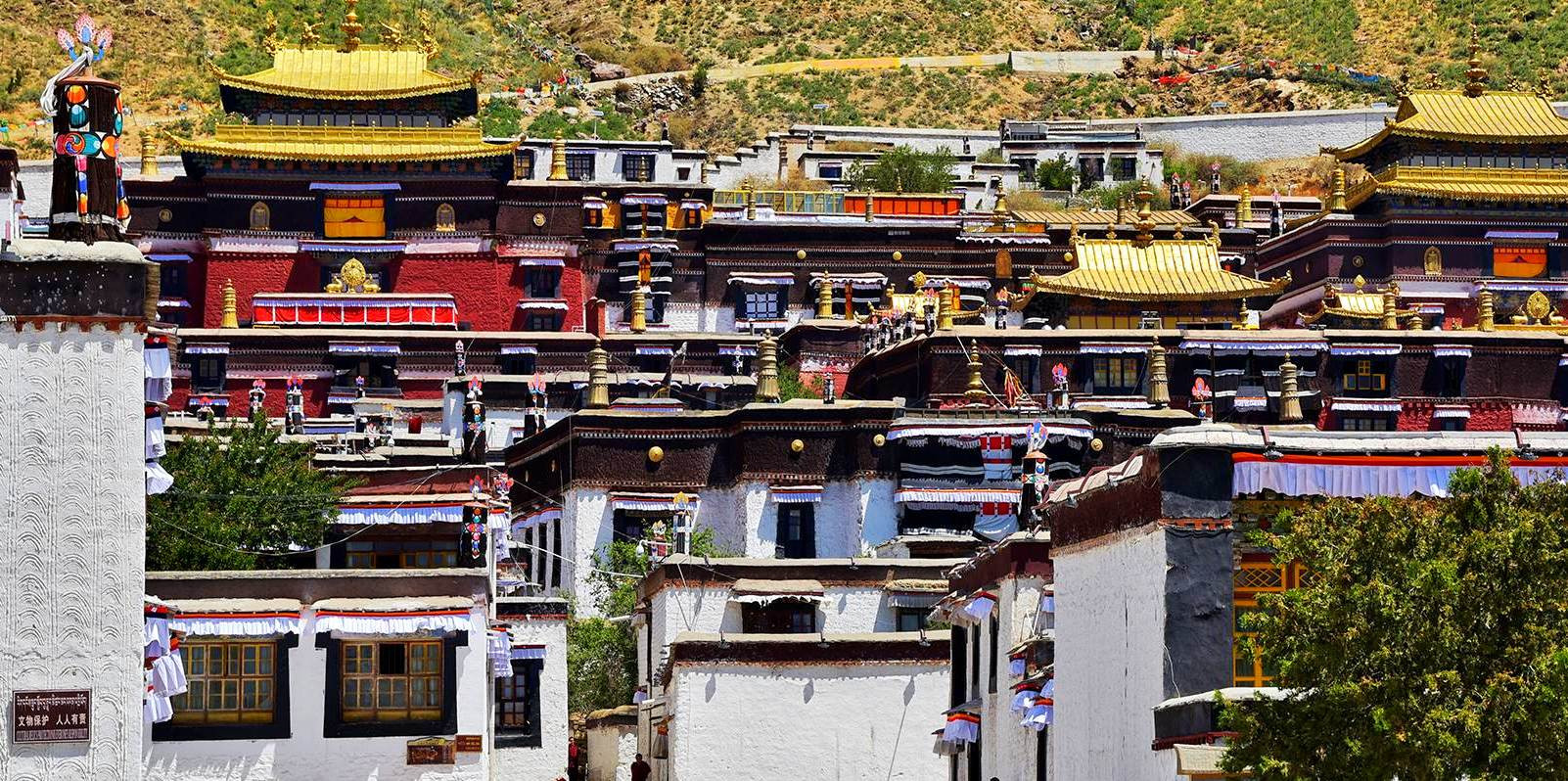
-
Location: Situated in the heart of Tibet's second-largest city, Tashilhunpo Monastery is easily accessible by road from Lhasa (approximately 6–7 hours). Its grand presence overlooks the city and serves as a centre of monastic learning and spiritual authority.
-
Historical Significance: Later becoming the official seat of the Panchen Lama, Tashilhunpo has played a key role in Tibetan politics, religion, and education. It’s one of the most historically rich Tibet travel destinations with over five centuries of uninterrupted monastic tradition.
-
Religious Importance: As a functioning monastery, it is home to hundreds of monks who study Buddhist philosophy and ritual. Pilgrims and visitors come to witness the spiritual atmosphere and attend religious ceremonies, making it one of the most vibrant Tibet tourism highlights.
-
Cultural Treasures: Tashilhunpo preserves an incredible collection of ancient thangkas, scriptures, and bronze statues, offering insight into Tibetan religious art and heritage. It is one of the top famous places in Tibet for cultural exploration.
-
Accessibility: Tashilhunpo is a regular stop on the classic Lhasa–Shigatse–Everest route, making it one of the most convenient and essential stops in any Tibet travel guide: top destinations.
Tashilhunpo Monastery is a place where history, devotion, and tradition converge. As the seat of the Panchen Lama, it stands as a symbol of continuity and faith in Tibetan Buddhism. For travellers looking to dive deeper into Tibet’s spiritual identity, this monastery is one of the best places to visit in Tibet.
Ganden Monastery
Ganden Monastery is one of the "Great Three" Gelugpa university monasteries of Tibet, along with Sera and Drepung. Perched high in the mountains east of Lhasa, it is one of the most spiritually significant and visually stunning Tibetan monasteries to visit, offering panoramic views and profound serenity. For those exploring spiritual sites in Tibet to explore, Ganden is an essential stop.
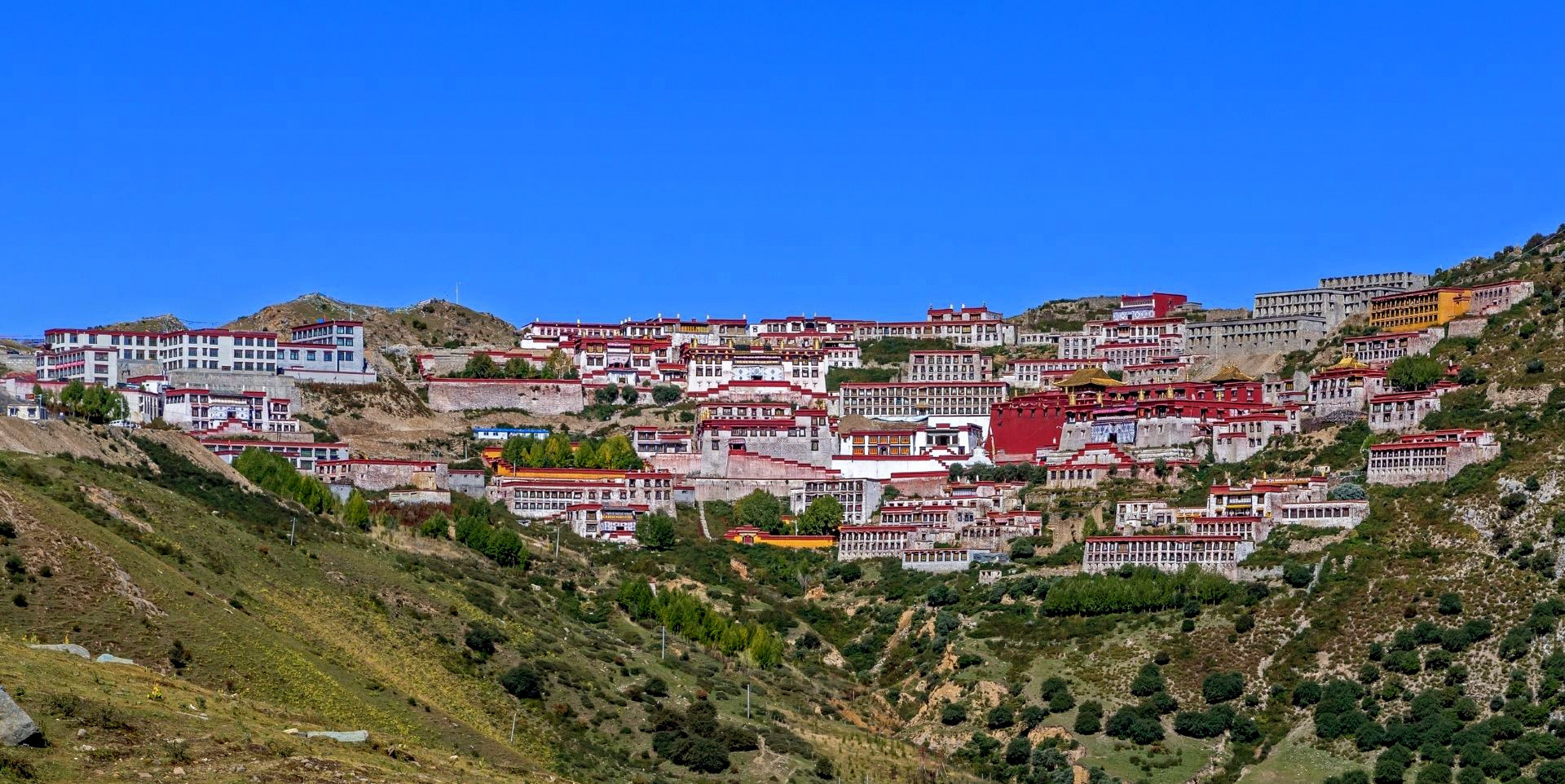
-
Location: Situated at an altitude of about 4,300 meters, Ganden Monastery sits atop Wangbur Mountain, overlooking the scenic Kyi Chu Valley. It's easily reachable by a short drive from Lhasa, making it one of the most accessible yet peaceful Tibet travel destinations.
-
Historical Significance: Ganden was established by Tsongkhapa, the founder of the Gelug (Yellow Hat) school of Tibetan Buddhism. It later became the main seat of this tradition. Tsongkhapa’s tomb is enshrined in a golden stupa within the monastery, making it a revered pilgrimage destination.
-
Architectural Features: The monastery complex features whitewashed chapels, golden roofs, and extensive debating courtyards. The setting alone makes it one of the most awe-inspiring Tibet sightseeing spots, ideal for contemplative visits and nature photography.
-
Religious Importance: Ganden continues to be a hub for monastic education and Buddhist practice. Pilgrims visit not only to pay respects to Tsongkhapa but also to perform the famous Ganden Kora—a sacred circuit around the mountain that offers breathtaking views and spiritual merit.
-
Cultural Treasures: Inside, visitors will find statues of Tsongkhapa, ancient scriptures, and beautifully preserved thangkas. The monastery also hosts annual festivals that showcase traditional music, dance, and rituals, offering cultural immersion into Tibet tourism highlights.
Ganden Monastery is a place where nature, devotion, and history come together. With its lofty setting, rich religious heritage, and peaceful atmosphere, it stands out as one of the top tourist attractions in Tibet. For anyone seeking a meaningful and scenic experience, Ganden is truly one of the best places to visit in Tibet.
Rongbuk Monastery
Located at the foot of the world’s tallest mountain, Rongbuk Monastery holds the title of the highest monastery in the world. Positioned near the Mount Everest Base Camp (Tibet side), it offers a rare combination of spiritual peace and rugged Himalayan beauty. It is one of the most unique spiritual sites in Tibet to explore, and a must-see for those visiting Everest.
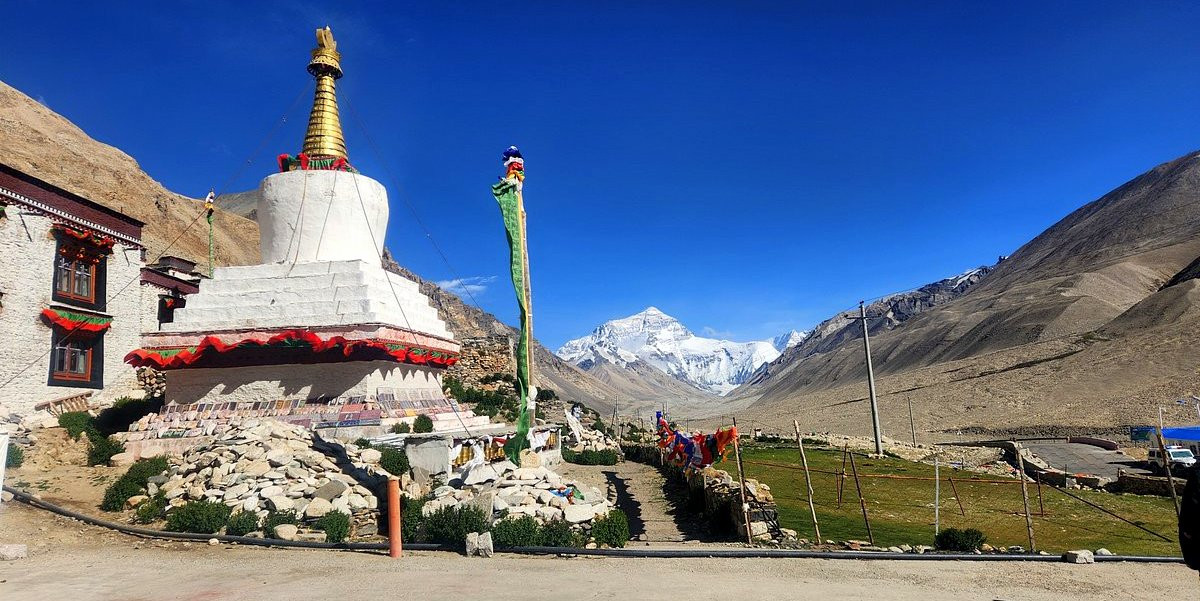
-
Location: Situated at an elevation of about 4,980 meters, Rongbuk Monastery is approximately 8 km from the Mount Everest Base Camp, Tibet side. It’s accessible via overland tours from Lhasa or Shigatse and is included in most itineraries to Everest.
-
Historical Significance: Rongbuk was established by Nyingma Lama Ngawang Tenzin Norbu as a meditation site for monks and hermits. It became a central point of spiritual activity in the Everest region and was once home to over 500 monks and nuns.
-
Religious and Cultural Importance: As a Nyingma (Ancient School) monastery, Rongbuk has strong ties to Tibetan Buddhist traditions. The site remains a pilgrimage destination and spiritual rest stop for those trekking to Everest, making it one of the most meaningful Tibetan monasteries to visit.
-
Scenic and Spiritual Setting: Rongbuk offers one of the most dramatic and uninterrupted views of Everest’s north face. It’s often cited among the most beautiful places in Tibet for photography, especially during sunrise and sunset when the mountain glows behind the monastery’s silhouette.
-
Accessibility: Most travellers visit Rongbuk en route to Everest Base Camp from Shigatse or Old Tingri. The road is rugged but manageable with a guided tour, making it a key stop in most Tibet travel guides: a top destination.
Rongbuk Monastery is more than just a viewpoint—it is a spiritual stronghold in one of Earth’s most remote and majestic places. With its rare location and sacred history, it’s one of the top tourist attractions in Tibet and a must-visit for anyone travelling to the Mount Everest Base Camp, Tibet side. For those seeking both inner peace and worldly awe, Rongbuk delivers an experience like no other.
Yungbulakang Palace
As the legendary birthplace of Tibetan civilisation, Yungbulakang Palace is one of the most historically significant and visually striking Tibetan landmarks. Perched on a rugged hilltop overlooking the fertile Yarlung Valley, it offers a captivating blend of history, legend, and panoramic scenery. For travellers interested in ancient sites and cultural origins, it is one of the best places to visit in Tibet.
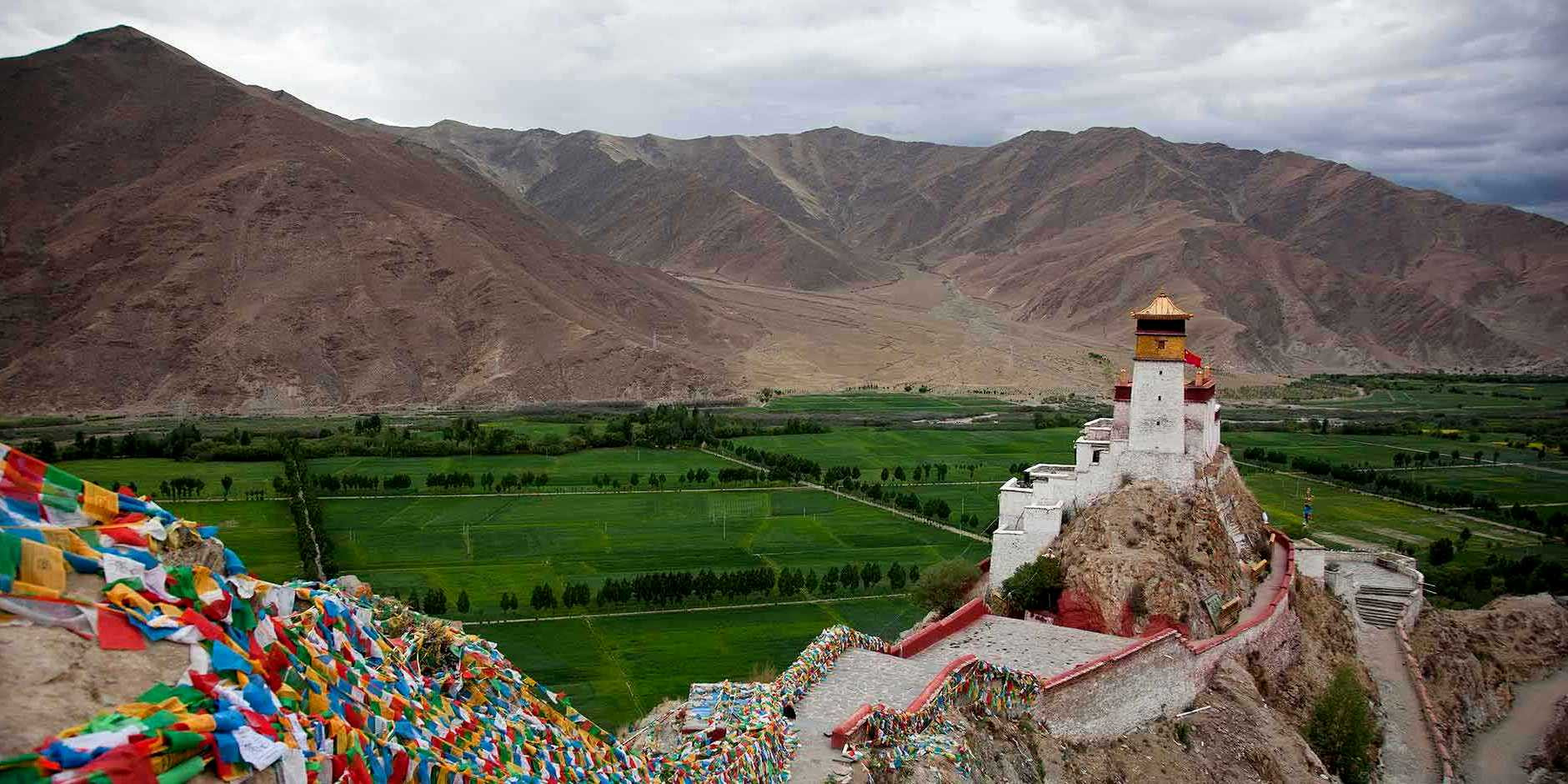
-
Location: Located about 190 km southeast of Lhasa, near the banks of the Yarlung Tsangpo River, Yungbulakang is easily accessible by road and often visited as part of a cultural tour through Tibet’s cradle of civilisation.
-
Historical Significance: According to legend, Yungbulakang was built in the 2nd century BCE for King Nyatri Tsenpo, Tibet’s first king. It later became a sacred site connected with early Tibetan dynasties and the arrival of Buddhism in Tibet. Its long history makes it one of the most essential Tibet travel destinations for understanding the roots of Tibetan identity.
-
Architectural Style: The palace features traditional Tibetan fortress architecture, built into the slope of the mountain. From its upper tiers, visitors enjoy sweeping views of the Yarlung Valley, making it a favourite among beautiful places in Tibet for photography.
-
Cultural and Religious Importance: Though originally a royal residence, Yungbulakang was converted into a Gelugpa monastery during the 7th century. Today, it serves as both a historical museum and a religious shrine, drawing visitors and pilgrims alike.
-
Accessibility: Yungbulakang is often included in heritage-focused tours that explore the Yarlung Valley, making it a valuable addition to any Tibet travel guide: a top destination itinerary.
Yungbulakang Palace offers a rare chance to step back into the legendary beginnings of Tibet. With its majestic hilltop setting, historical legacy, and spiritual importance, it is one of the most rewarding must-see places in Tibet. For those seeking both history and scenic wonder, Yungbulakang is an unforgettable part of your Tibetan journey.
Tips for Top 10 best places to visit in Tibet
Exploring the best places to visit in Tibet is a once-in-a-lifetime experience, filled with majestic landscapes, sacred sites, and centuries-old culture. Whether you're heading to the Mount Everest Base Camp (Tibet side) or meditating at Samye Monastery, these essential travel tips will help ensure a smooth and unforgettable journey through the top tourist attractions in Tibet.
-
Acclimatise Properly Before High-Altitude Travel: Most of Tibet sits above 3,500 meters. Spend at least 2–3 days acclimating in Lhasa before visiting higher-altitude destinations like Namtso Lake, Mount Everest Base Camp, or Rongbuk Monastery to reduce the risk of altitude sickness.
-
Dress in Layers and Pack for All Weather Conditions: Tibetan weather changes quickly. Even in summer, mornings and evenings can be cold, especially at high-altitude Tibet travel destinations like Yamdrok Lake or Ganden Monastery. Bring warm layers, waterproof jackets, gloves, and sun protection.
-
Time Your Visit Between April and October: The best time to explore the top 10 places to visit in Tibet is between April and October, when most areas are accessible and the weather is relatively mild. Avoid the harsh winter months, especially if you're heading to remote locations like Namtso Lake or Mount Everest Base Camp.
-
Expect Limited Connectivity in Remote Areas: Wi-Fi and mobile signal are available in cities like Lhasa and Shigatse, but access may be limited or non-existent in remote areas such as Rongbuk Monastery or Namtso Lake. Download maps and important documents in advance.
-
Travel with a Registered Tour Operator: Independent travel in Tibet is restricted for foreign visitors. You must book through a licensed tour agency like Relax Getaways, which will provide permits, guides, transportation, and a planned itinerary across all major Tibet tourism highlights.
-
Stay Hydrated and Eat Light: The high altitude can affect digestion and energy levels. Drink plenty of water, eat small meals, and avoid alcohol and smoking in the first few days. Local Tibetan food, such as tsampa, momos, and butter tea, is worth trying in moderation.
-
Carry Cash for Remote Destinations: While Lhasa and Shigatse have ATMS and accept digital payments, remote spots like Ganden Monastery or Yungbulakang Palace often require cash for entry tickets, snacks, or souvenirs. Keep some Chinese Yuan handy.
-
Respect Wildlife and Natural Landscapes: Many Tibet sightseeing spots like Yamdrok Lake and Namtso Lake are ecologically fragile.
Tibet is unlike anywhere else on Earth. With the right planning and respect for its unique environment and traditions, your journey through the famous places in Tibet will be unforgettable. Whether you're soaking in the serenity of Tashilhunpo Monastery, standing in awe at Potala Palace, or watching sunrise over Everest, each destination offers its magic.
Ideal Time for Top 10 best places to visit in Tibet
Tibet’s climate varies greatly with the seasons due to its high altitude. Here’s a quick overview of what each season offers for travellers exploring the top 10 best places to visit in Tibet:
-
Spring (April to May): Spring is the beginning of the travel season. Temperatures are mild, skies are clear, and snow begins to melt, making most regions accessible. Tourist crowds are still low, and visibility for mountain views and photography is excellent. Great for cultural travel and scenic exploration.
-
Summer (June to August): Summer is the warmest and busiest season. It brings green landscapes, blooming wildflowers, and vibrant festivals. Rain is possible (especially in the afternoons), but most days are suitable for travel. This is the peak time for visiting high-altitude regions and remote areas.
-
Autumn (September to October): Autumn offers the clearest skies and best weather of the year. Temperatures are cool but comfortable, and visibility is ideal for trekking, mountain views, and photography. Landscapes are colourful and fresh after the summer rains. Perfect for all types of travel.
-
Winter (November to March): Winter is the coldest and quietest season. While some remote areas may be closed due to snow, major cities and cultural sites remain open. Fewer tourists, clear skies, and lower prices make it ideal for a peaceful and budget-friendly trip focused on cultural experiences.
Your ideal travel season depends on your priorities—whether you're seeking stunning landscapes, spiritual experiences, or cultural immersion. For expertly timed and well-managed travel, Relax Getaways is here to design the perfect journey through Tibet’s changing seasons.
Tibet is a land of holy places, magnificent vistas, and vibrant civilisation. Among the top ten best Tibet destinations, one finds an ideal balance of natural beauty and spiritual depth. Whether you want excitement or quiet, these sites show the real core of the Himalayas. Trust Relax Getaways to show you the path for a purposeful and organised trip.
FAQs for Top 10 best places to visit in Tibet
Q: What travel documents do I need to visit Tibet?
A: To visit Tibet, you must obtain a Chinese visa and a Tibet Travel Permit. Additional permits are required for restricted areas like Everest Base Camp. These permits can only be arranged through a registered travel agency.
Q: When is the best time to visit Tibet?
A: The optimal time to visit Tibet is from April to October. During these months, the weather is milder, and the roads are more accessible. This period also coincides with many vibrant local festivals.
Q: How should I prepare for the high altitude in Tibet?
A: Start by acclimatising in Lhasa or another low-altitude area for a few days upon arrival. Stay hydrated, consume high-calorie foods, and consult a healthcare provider for advice on preventing and treating altitude sickness.
Q: What are the must-see places in Tibet?
A: Essential sites in Tibet include the Potala Palace, Jokhang Temple, Namtso Lake, Mount Everest Base Camp, Samye Monastery, Yamdrok Lake, Tashilhunpo Monastery, Ganden Monastery, Rongbuk Monastery, and Yungbulakang Palace.
Q: What should I pack for a trip to Tibet?
A: Bring warm clothing in layers, sun protection (sunglasses, sunscreen, hat), sturdy shoes, a first-aid kit, regular medications, and high-energy snacks for trekking.
Q: Are there specific cultural customs I should be aware of?
A: Yes, show respect by dressing modestly, especially at religious sites, walking clockwise around temples and sacred objects, and always asking for permission before taking photos of people or ceremonies.
Q: What kind of food can I expect in Tibet?
A: Tibetan cuisine typically includes tsampa (barley flour), butter tea, yak meat, and dumplings. Vegetarian options are limited outside of urban centres.
Q: Is it safe to travel in Tibet?
A: Tibet is generally safe for travellers. However, due to its sensitive political climate, it's important to stay updated on current events, follow local laws, and adhere to the advice of your tour operator.
Q: How can I respect Tibet’s environment during my visit?
A: Follow Leave No Trace principles: carry out all trash, conserve water, avoid disturbing wildlife, and stick to established trails. Supporting local conservation initiatives and eco-friendly tours also helps preserve Tibet's natural environment.
Q: Can I explore Tibet independently?
A: Non-Chinese citizens cannot travel independently in Tibet. All visits must be organised through an official tour with a recognised travel agency.
For the Nepal tour, please click here.
If you are looking for different kinds of Nepal Tours or Trekking Packages, feel free to contact us.
